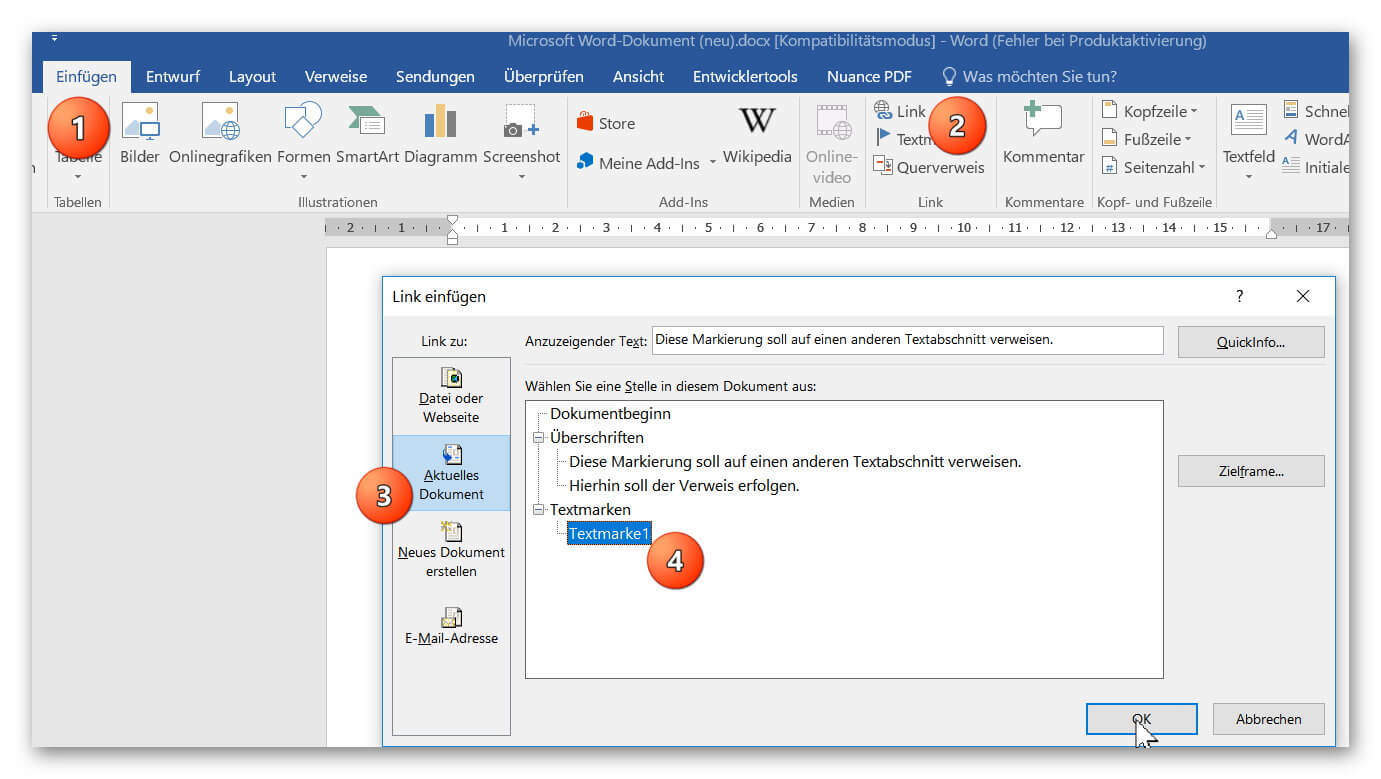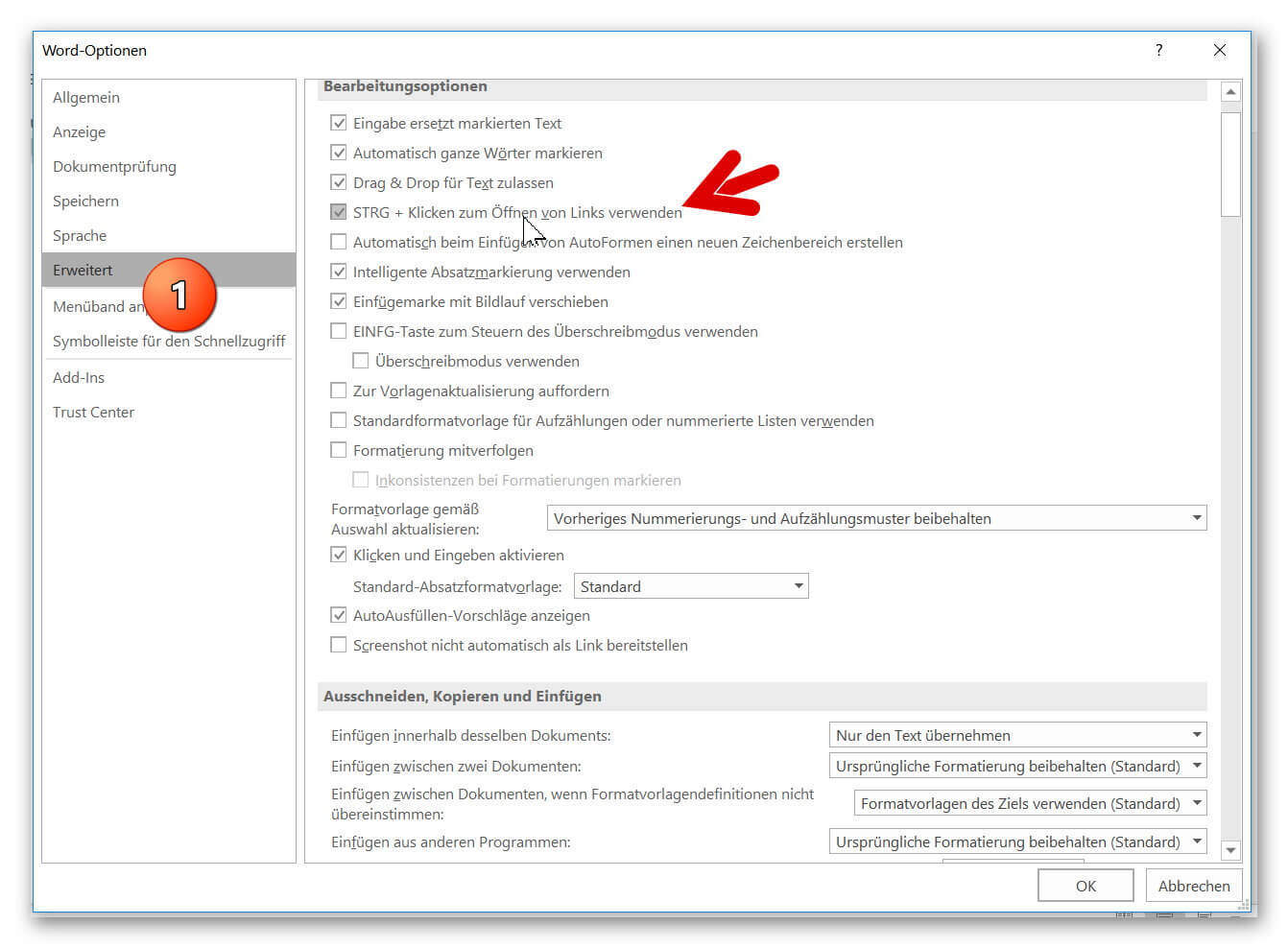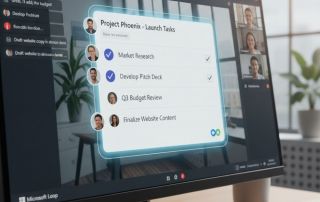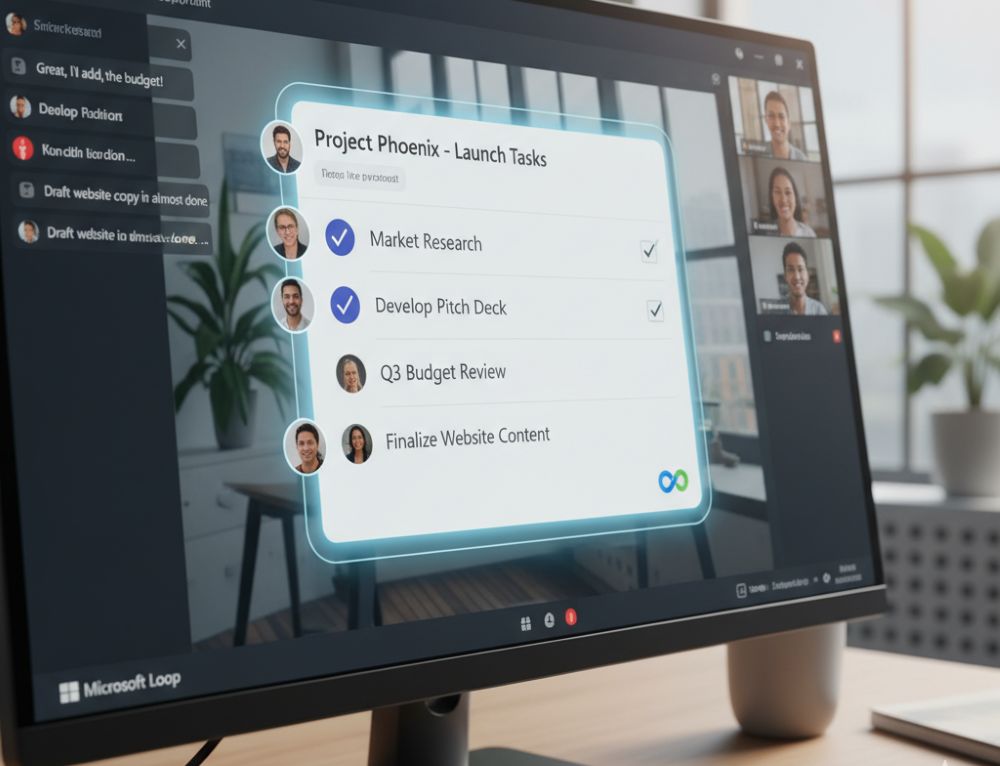Use bookmarks and cross-references in Word
Surely you’ve already thought about it, that in long Word documents it would not be practical to constantly scroll through textual pages to search for certain passages of text, but to move as comfortably as on a web page by clicking through your pages.
Fortunately, the solution to this problem is quite simple, and is based on the functionality of the table of contents in Word.
As it is done in Word 2016, and you can create such a dynamic document, you will find out in our article.

Use bookmarks and cross-references in Word
Surely you’ve already thought about it, that in long Word documents it would not be practical to constantly scroll through textual pages to search for certain passages of text, but to move as comfortably as on a web page by clicking through your pages.
Fortunately, the solution to this problem is quite simple, and is based on the functionality of the table of contents in Word.
As it is done in Word 2016, and you can create such a dynamic document, you will find out in our article.

1. Set bookmarks in Word
1. Set bookmarks in Word
In our small example, we have created 2 sections of text.
The goal should be that we can click on a section of text, or a word, and then land directly in the 2nd text section.
First, we set a text marker in the target section.
For this purpose we should mark the headline or the beginning of the section, and then go to the tab: “Paste” on “Bookmark” and give our bookmark a unique, and unique (if we later want to use more than one bookmark) name.
See picture: (click to enlarge)
In our small example, we have created 2 sections of text.
The goal should be that we can click on a section of text, or a word, and then land directly in the 2nd text section.
First, we set a text marker in the target section.
For this purpose we should mark the headline or the beginning of the section, and then go to the tab: “Paste” on “Bookmark” and give our bookmark a unique, and unique (if we later want to use more than one bookmark) name.
See picture: (click to enlarge)
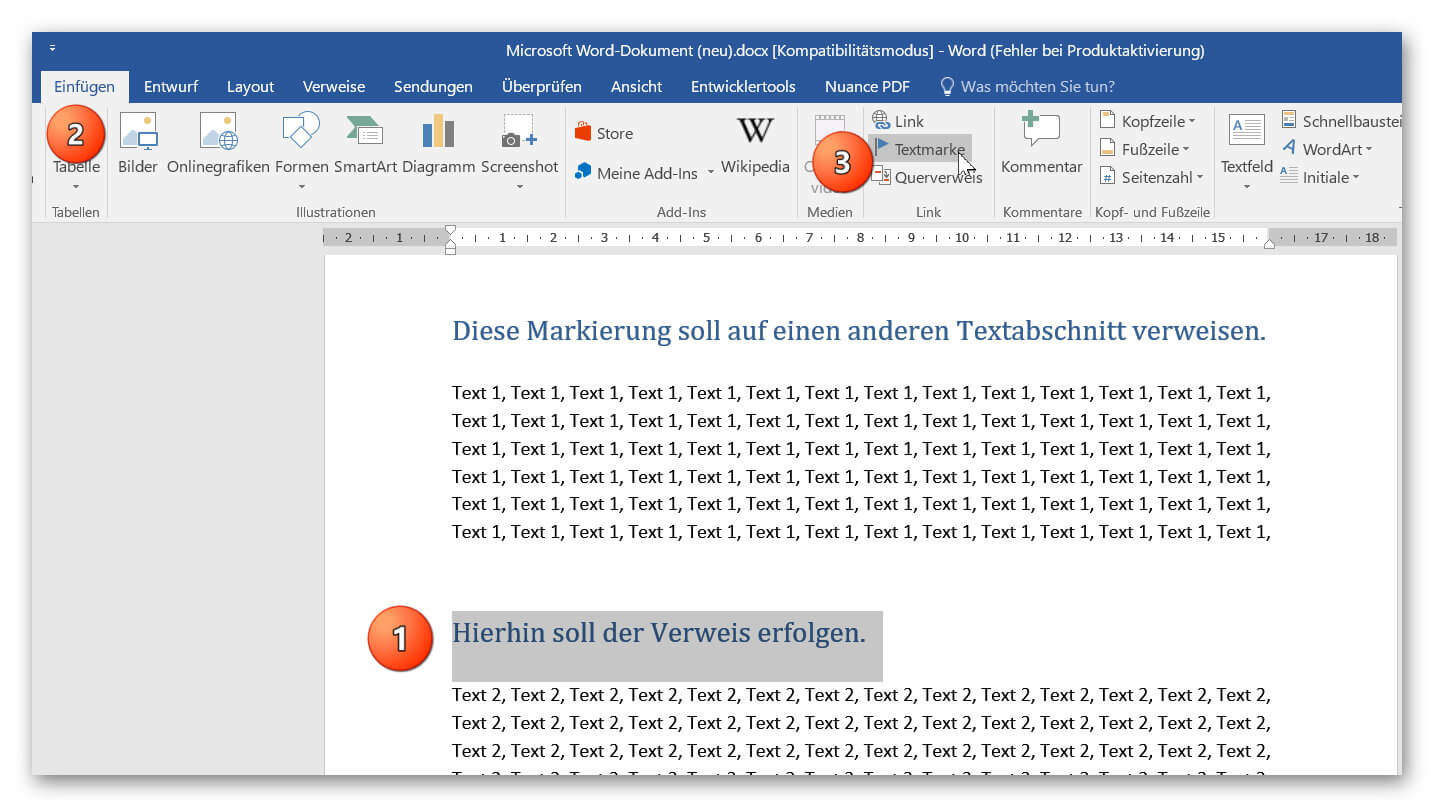
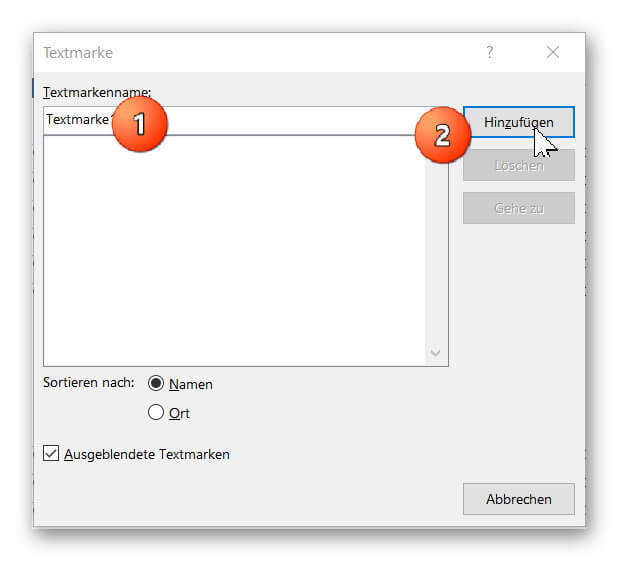
2. Set internal links in Word.
2. Set internal links in Word.
In the previous step, we set our goal, where we want to land later.
Next we just have to define which text components should refer to this goal.
To do this, mark the word next, or the text section that represents the starting point, in the tab: “Paste” on “Link” and in the following dialog window select: “Link to: Current document”.
There, the desired text marker out, and confirm your choice with “OK”.
From now on, your document is dynamic and you can click on your internal link while holding down the CTRL key + left mouse button.
In this way, you can jump through a document by skillfully setting internal bookmarks and links without having to scroll through page by page text.
Of course, you can apply the same principle to images or shapes that you have inserted in your document.
See picture: (click to enlarge)
In the previous step, we set our goal, where we want to land later.
Next we just have to define which text components should refer to this goal.
To do this, mark the word next, or the text section that represents the starting point, in the tab: “Paste” on “Link” and in the following dialog window select: “Link to: Current document”.
There, the desired text marker out, and confirm your choice with “OK”.
From now on, your document is dynamic and you can click on your internal link while holding down the CTRL key + left mouse button.
In this way, you can jump through a document by skillfully setting internal bookmarks and links without having to scroll through page by page text.
Of course, you can apply the same principle to images or shapes that you have inserted in your document.
See picture:
3. Run link in Word directly
3. Run link in Word directly
By the way, you can only execute links in Word by using CTRL + Left mouse button. By the way, this is a security setting that Microsoft installed for a good reason and set as default.
Because as someone who did not create this document, I can assume that the link points to an expected point in the document, but I can not rely on it.
It is also quite possible that such a link to a self-executing exe. File refers to a dubious website or other harmful to my PC content.
Therefore, as soon as you move the mouse over the link, the destination of the link to the control is displayed in a small context window.
To override the default, and click through your document just as you would on an internet page, just go to the tab:
“File” – “Options” – “Advanced”
and look there in the section editing options the entry: “CTRL + click to open links”
and deactivate the hook there.
See picture: (click to enlarge)
By the way, you can only execute links in Word by using CTRL + Left mouse button. By the way, this is a security setting that Microsoft installed for a good reason and set as default.
Because as someone who did not create this document, I can assume that the link points to an expected point in the document, but I can not rely on it.
It is also quite possible that such a link to a self-executing exe. File refers to a dubious website or other harmful to my PC content.
Therefore, as soon as you move the mouse over the link, the destination of the link to the control is displayed in a small context window.
To override the default, and click through your document just as you would on an internet page, just go to the tab:
“File” – “Options” – “Advanced”
and look there in the section editing options the entry: “CTRL + click to open links”
and deactivate the hook there.
See picture: (click to enlarge)
Popular Posts:
KI im Büroalltag: Dein neuer unsichtbarer Kollege
KI wird dich nicht ersetzen – aber wer sie nutzt, hat die Nase vorn. Mach KI zu deinem Co-Piloten im Büro! Wir zeigen 4 konkrete Hacks für schnellere E-Mails, bessere Meeting-Notizen und gelöste Excel-Probleme. Starte heute durch, ganz ohne IT-Studium.
Fünf vor Zwölf: Wie Sie erkennen, dass Sie kurz vor dem Burnout stehen
Erschöpfung ist normal, doch wenn das Wochenende keine Erholung mehr bringt und Zynismus die Motivation ersetzt, stehen Sie kurz vor dem Burnout. Erfahren Sie, welche 7 Warnsignale Sie niemals ignorieren dürfen und warum es jetzt lebenswichtig ist, die Notbremse zu ziehen
Die Renaissance des Büros: Warum Präsenz manchmal unschlagbar ist
Homeoffice bietet Fokus, doch das Büro bleibt als sozialer Anker unverzichtbar. Spontane Innovation, direktes Voneinander-Lernen und echtes Wir-Gefühl sind digital kaum zu ersetzen. Lesen Sie, warum Präsenz oft besser ist und wie die ideale Mischung für moderne Teams aussieht.
New Work & Moderne Karriere: Warum die Karriereleiter ausgedient hat
Die klassische Karriereleiter hat ausgedient. New Work fordert ein neues Denken: Skills statt Titel, Netzwerk statt Hierarchie. Erfahre, warum das "Karriere-Klettergerüst" deine neue Realität ist und wie du dich mit 4 konkreten Schritten zukunftssicher aufstellst.
Die Homeoffice-Falle: Warum unsichtbare Arbeit deine Beförderung gefährdet
Produktiv im Homeoffice, doch befördert wird der Kollege im Büro? Willkommen in der Homeoffice-Falle. "Proximity Bias" lässt deine Leistung oft unsichtbar werden. Lerne 4 Strategien, wie du auch remote sichtbar bleibst und deine Karriere sicherst – ganz ohne Wichtigtuerei.
Microsoft Loop in Teams: The revolution of your notes?
What exactly are these Loop components in Microsoft Teams? We'll show you how these "living mini-documents" can accelerate your teamwork. From dynamic agendas to shared, real-time checklists – discover practical use cases for your everyday work.
Popular Posts:
KI im Büroalltag: Dein neuer unsichtbarer Kollege
KI wird dich nicht ersetzen – aber wer sie nutzt, hat die Nase vorn. Mach KI zu deinem Co-Piloten im Büro! Wir zeigen 4 konkrete Hacks für schnellere E-Mails, bessere Meeting-Notizen und gelöste Excel-Probleme. Starte heute durch, ganz ohne IT-Studium.
Fünf vor Zwölf: Wie Sie erkennen, dass Sie kurz vor dem Burnout stehen
Erschöpfung ist normal, doch wenn das Wochenende keine Erholung mehr bringt und Zynismus die Motivation ersetzt, stehen Sie kurz vor dem Burnout. Erfahren Sie, welche 7 Warnsignale Sie niemals ignorieren dürfen und warum es jetzt lebenswichtig ist, die Notbremse zu ziehen
Die Renaissance des Büros: Warum Präsenz manchmal unschlagbar ist
Homeoffice bietet Fokus, doch das Büro bleibt als sozialer Anker unverzichtbar. Spontane Innovation, direktes Voneinander-Lernen und echtes Wir-Gefühl sind digital kaum zu ersetzen. Lesen Sie, warum Präsenz oft besser ist und wie die ideale Mischung für moderne Teams aussieht.
New Work & Moderne Karriere: Warum die Karriereleiter ausgedient hat
Die klassische Karriereleiter hat ausgedient. New Work fordert ein neues Denken: Skills statt Titel, Netzwerk statt Hierarchie. Erfahre, warum das "Karriere-Klettergerüst" deine neue Realität ist und wie du dich mit 4 konkreten Schritten zukunftssicher aufstellst.
Die Homeoffice-Falle: Warum unsichtbare Arbeit deine Beförderung gefährdet
Produktiv im Homeoffice, doch befördert wird der Kollege im Büro? Willkommen in der Homeoffice-Falle. "Proximity Bias" lässt deine Leistung oft unsichtbar werden. Lerne 4 Strategien, wie du auch remote sichtbar bleibst und deine Karriere sicherst – ganz ohne Wichtigtuerei.
Microsoft Loop in Teams: The revolution of your notes?
What exactly are these Loop components in Microsoft Teams? We'll show you how these "living mini-documents" can accelerate your teamwork. From dynamic agendas to shared, real-time checklists – discover practical use cases for your everyday work.

